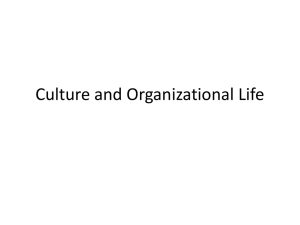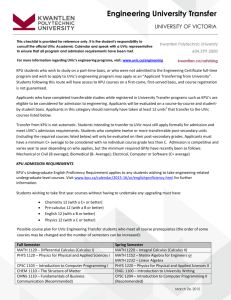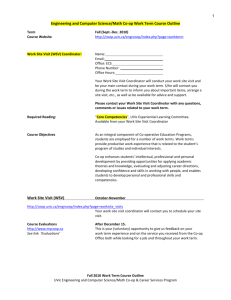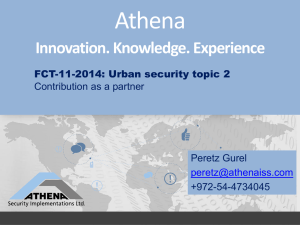What is your CQ?
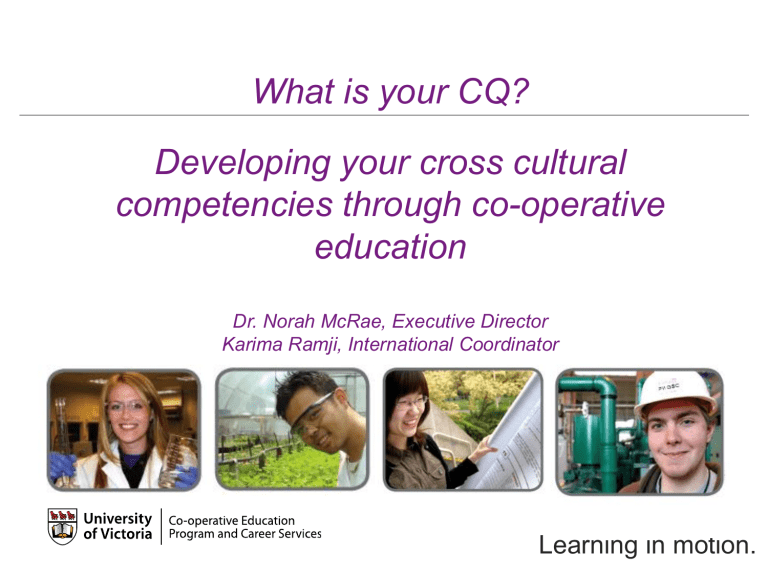
What is your CQ?
Developing your cross cultural competencies through co-operative education
Dr. Norah McRae, Executive Director
Karima Ramji, International Coordinator
Learning in motion.
How did we get here?
• CANEU-COOP program
• Research on CQ development of students
• WatCACE funding to continue research and curriculum development
Learning in motion.
Session Outline:
• What is culture?
• What does it mean to be effective in a cross cultural setting?
• Cultural intelligence (CQ) framework
• Putting it into motion: D.R.I.V.E.
• The UVic approach
Learning in motion.
What is Culture?
Learning in motion.
The Cultural Iceberg
Learning in motion.
Navigating cultural icebergs using
Cultural Intelligence
Cultural intelligence is the ability to be effective in a cross-cultural setting (Earley & Ang, 2003)
Learning in motion.
Cultural Intelligence
Video clip: “CQ Wheel” (3:13)
Learning in motion.
The four basic aspects of Cultural
Intelligence
CQ - Drive
A person's interest and confidence in functioning effectively in culturally diverse settings.
• Intrinsic Interest - deriving enjoyment from culturally diverse experiences
• Extrinsic Interest - gaining benefits from culturally diverse experiences
• Self-efficacy - having the confidence to be effective in culturally diverse situations
Learning in motion.
The four basic aspects of Cultural
Intelligence
CQ - Knowledge
A person's knowledge about how cultures are similar and how cultures are different.
• Business - knowledge about economic and legal systems
• Interpersonal - knowledge about values, social interaction norms, and religious beliefs
• Socio-linguistics - knowledge about rules of languages and rules for expressing non-verbal behaviors
Learning in motion.
CQ Strategy
How a person makes sense of culturally diverse experiences.
Occurs when people make judgments about their own thought processes and those of others
• Awareness - knowing about one's existing cultural knowledge
• Planning - strategizing before a culturally diverse encounter
• Checking - checking assumptions and adjusting mental maps when actual experiences differ from expectations
Learning in motion.
CQ Behavior
A person's capability to adapt verbal and nonverbal behavior to make it appropriate to diverse cultures.
This involves having a flexible repertoire of behaviors to suit a variety of situations
• Non-Verbal - modifying non-verbal behaviors (e.g., gestures, facial expressions)
• Verbal - modifying verbal behaviors (e.g., accent, tone)
Learning in motion.
4 CQ Capabilities
Cultural Intelligence Framework(CQ)
How should I adapt?
Speech Acts
Verbal
Nonverbal
4. CQ
ACTION
1. CQ
DRIVE
What’s my motivation for this interaction?
Intrinsic
Extrinsic
Self-Efficacy
What ’s my plan?
Planning
Awareness
Checking
3. CQ
STRATEGY
2. CQ
KNOWLEDGE
What cultural understanding do I need?
Business
Values & Norms
Socio-Linguistic
Leadership
© 2010 Cultural Intelligence
Center, www.culturalq.com
Learning in motion.
© 2012 Cultural Intelligence Center
Putting CQ in motion at UVic
CANEU-COOP research
Cross-cultural competencies
Intercultural Service
Learning
Publications
Students going abroad
International students on campus
Curriculum for various stakeholders
Faculty and Staff
Employers?
Learning in motion.
Putting CQ in motion at UVic
CANEU-COOP research
Cultural Intelligence Report for 2012-2013
Learning in motion.
Connecting the dots…
• Employability – why would my employer, ASYS Group in Germany, value these skills?
Johannes Mueller, CANEU-COOP student at UVic
Learning in motion.
Putting CQ in motion
Cross cultural competencies
Based on CQ framework
Students’ learning objectives, midterm and final assessments
Employer assessments
Learning in motion.
Competency Framework
M.Barber, Bcom student
Cross cultural knowledge
I have learned so much about Japan's culture as well as KSU's working culture since I started my co-op here. There are some things that I don't agree with with the Japanese working style.
For example:
• many of my co-workers stay at work until 12~1am everyday.
• positive feedback is not really used
Even though I dislike it, I respect it.... I hope to work in many different countries to experience different working cultures!
Learning in motion.
Competency Framework
M.Barber, Bcom student
Cross cultural behaviour
….
with my time here I have adapted to it. I have however mentioned to my supervisors the importance of positive feedback. At first I was only getting negative feedback, however now for the past 2 months they have been giving me positive as well!
Learning in motion.
Competency Framework
• Insert a sample assessment – Mitraya
Barber (Kyoto Sangyo University)
Learning in motion.
Putting CQ in motion at UVic
Intercultural
Service Learning
Offered in Fall
2012
Multi –faculty initiative
Open to all students
Learning in motion.
International Co-op and Career at UVic
Intercultural Service Learning
200 level
1.5 credit course,
Hosted by Pacific and
Asian Studies
Motivation,
Strategy, knowledge, behaviour
Faculty members from
PAAS, Psychology,
Education, and Equity &
Diversity office
Diversity, culture, language
Targeted to domestic and international Reflectio n students at UVic
Service learning in an intercultural organization
6 weeks
@6 hrs/week
Learning in motion.
Putting CQ in motion at UVic
Enhancing Cultural Intelligence through Co-operative and Work-
Integrated Education
Publications
Students as Culturally Intelligent
Change Agents: Global
Citizenship and the Workplace
Conferences
Presentations, interviews
University Affairs interview
Learning in motion.
Putting CQ in motion
Students going abroad
Workshops for students re: CQ
Resources that help with learning about host culture
Midterm and final assessments
Debriefing sessions
Learning in motion.
Putting CQ in motion at UVic: student voices
Everyday there is always something new happening to me. For example, my first time taking subway here, the train stopped in front of me. I was just standing still and waiting for the door open automatically as it does both in Canada and in China. But here, nope. You need to press the button to open the door by yourself.
At the pre-departure lecture at
UVic, we talked about values such as power distance, punctuality, team work and long/short term thinking -my experience points them out for me time by time. I am glad that I am prepared and now I can realize and pay more attention to the culture difference and not get mad.
The guy behind me with his bike stared at me weirdly as thought I was crazy or in my own spiritual world without paying attention to the outside world. He stepped in front of me and pressed the door open for me. lol Such thing almost happened to me everyday. hahahaha.
Zhijie Yin, ENG student
Learning in motion.
Putting CQ in motion
International students
Workshop series
Understanding culture & cross-cultural competencies
Connecting crosscultural competencies to your experiences
Cross-cultural competencies in your job search
How culture plays out in interviews
Cross-cultural competencies in the workplace
Learning in motion.
Putting CQ in motion
DRIVE to crosscultural effectiveness
Drive
Reflect
Initiate
Values
Evaluate
Learning in motion.
Putting CQ in motion
A curricular module for Employers?
Learning in motion.
Future plans
• Continue research
• Develop online curriculum
• Continue to share findings and curriculum in the co-op education context
Learning in motion.
References
Earley, P. C., & Ang, S. (2003). Cultural Intelligence: Individual Interactions Across Cultures .
Stanford, CA.: Stanford University Press.
Ang, S., & Van Dyne, L. (2008). Conceptualization of Cultural Intelligence: Definition,
Distinctiveness, and Nomological Network. In S. Ang & L. V. Dyne (Eds.), Handbook of cultural intelligence: theory, measurement, and applications (pp. 3-15). Armonk, NY: M.E. Sharpe.
The Cultural Intelligence Difference: Master the One Skill You Can’t do Without in Today’s Global
Economy by David Livermore (AMACOM 2011)
Customs of the World: Using Cultural Intelligence To Adapt, Wherever You Are by David
Livermore (The Great Courses 2013) http://www.culturalq.com/books.html
Learning in motion.
Thank you!
Questions?
Dr. Norah McRae, nmcrae@uvic.ca
Karima Ramji, ramjik@uvic.ca
Learning in motion.

